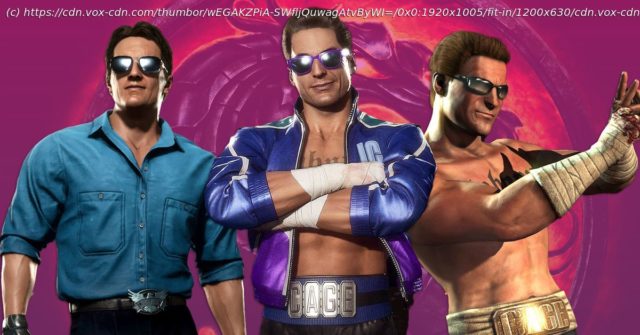Johnny Cage, the very first character that Mortal Kombat co-creators Ed Boon and John Tobias filmed for the 1992 game, is still the beating, bloody heart of the franchise.
Johnny Cage has been kind of a big deal for Mortal Kombat from the beginning. Scorpion and Sub-Zero may be the faces of the franchise, and Liu Kang its hero, but Johnny is critical to Mortal Kombat’s genesis.
He was the very first character that series co-creators Ed Boon and John Tobias filmed for 1992’s Mortal Kombat. Part stand-in for and part homage to Jean-Claude Van Damme — Johnny’s original look is ripped from the actor’s costume from Bloodsport — Cage was the closest thing MK would have to an everyman.
“Johnny Cage represented the audience’s perspective on what it would be like to be introduced to this crazy supernatural tournament called Mortal Kombat,” Boon recently told me.
Cage is also core to the creation of one of Mortal Kombat’s defining features: the Fatality.
And even after two franchise reboots, canonically dying (at least twice), and a whole-cloth timeline reset in Mortal Kombat 1, Johnny Cage is still that guy: a lovable asshole, a cocksure Hollywood martial artist who is strangely relatable, and the primary source of comic relief in a game series famous for its blood-spurting decapitations and disemboweling finishing moves.
Johnny Cage isn’t even his real name. In Mortal Kombat fiction, the Hollywood actor was born John Carlton. Cage is just his stage name; but when Boon and Tobias first conceived of Mortal Kombat’s cast of characters, he was known as Michael Grimm.The birth of Johnny Cage
Mortal Kombat was famously born of a failed plan to build an arcade game around Jean-Claude Van Damme. The actor, then famous for his roles in Kickboxer, Double Impact, and Universal Soldier, rebuffed a pitch to be digitized by Midway Games for Van Damme: The Arcade Game. So Boon and Tobias, inspired by the popularity of Capcom’s Street Fighter 2, set out to make their own fighting game.
Tobias would define the archetypes for Mortal Kombat’s fighters. No. 1 on the list was the game’s hero, Liu Kang, inspired by martial arts actors Gordon Liu and Bruce Lee, according to Tobias. Just behind him, at No. 2, was Michael Grimm, envisioned as a “sidekick” to Liu Kang. Grimm’s first biography described him as “a martial arts superstar, trained throughout his life by great masters from around the world. He is the current box-office champ and star of such movies as ‘Dragon’s Fist,’ ‘Dragon’s Fist II,’ and the award winning ‘Sudden Violence.’”
Boon and Tobias hoped that Van Damme would play him. “We saw JCVD’s character as the Han Solo to Liu Kang’s Luke Skywalker,” Tobias said in a 2021 thread on X recalling the early days of Johnny Cage’s creation.
Even after Van Damme turned down the role, “Ed and I thought the character as a Hollywood star would still work in our game,” Tobias said. “We even kept my little pencil doodle that had the character in JCVD’s Bloodsport attire.”
Tobias and Boon picked Michael Grimm as the first character to shoot for Mortal Kombat, in part, Tobias recalled, “to excise the roller coaster vibes we had just been [through] trying to land JCVD.” Tobias enlisted local martial artist friends from the Chicago area for the shoot. Daniel Pesina was brought in to perform as Michael Grimm, wearing attire similar to what Van Damme wore in Bloodsport: spandex shorts and a belt, plus studded bracers and slippers. To sell the smug Hollywood actor stereotype, Pesina would throw on sunglasses at the end of every round.
“Early versions of Johnny Cage didn’t really have a fighting style per se,” Boon told Polygon. “We never sat down and asked ourselves, ‘What kind of fighting style should Johnny Cage have?’ We had a list of punches and kicks […] simple attacks like high kick, medium kick, low kick, and the same rapid-fire punch system that all of the characters shared. His special moves and Fatalities for the most part were created using those same basic attack animations. For example, his shadow kick was simply his medium kick with a special effect applied and we propelled him forward. We had a very limited amount of memory for the game’s animations, so we had to be resourceful.”
Johnny Cage’s initial combat design got done in post. “We had a list of basic moves that we worked through,” Tobias told Polygon. “One of them was ‘projectile.’ We went through several throwing motions on set. Afterward, while processing the frames, we picked the fling motion that we ended up using, and I created the glowing green projectile. Ed created the shadow kick while programming, and I created the tinted palettes we used on Cage’s frames. That stuff happened after our filming session. […] We did not have either of [those moves] specifically in mind when recording in [the] studio.”
But as fans know, it’s not just the moves but the attitude that defines Johnny Cage. That came later too, though. “Back then we didn’t have the technology to give Johnny Cage the amount of pizazz and flair that he has now,” said Boon. “So, he was a little bit of a tamer version of the Johnny Cage that players know and love today.”
Boon and Tobias did, however, have the concept of the Fatality in mind while filming Pesina as Cage, albeit in a very different form. Originally, only the big boss of Mortal Kombat, Shang Tsung, would be equipped with a fatal finishing move. According to Tobias, early iterations of Mortal Kombat would have Shang Tsung behead the player with his sword at the end of his boss fight.






